The Radeon HD 4850 & 4870: AMD Wins at $199 and $299
by Anand Lal Shimpi & Derek Wilson on June 25, 2008 12:00 AM EST- Posted in
- GPUs
Building a RV770
We did this with NVIDIA's GT200 and it seemed to work out well, so let's start at the most basic level with AMD's RV770. Meet the Stream Processing Unit:
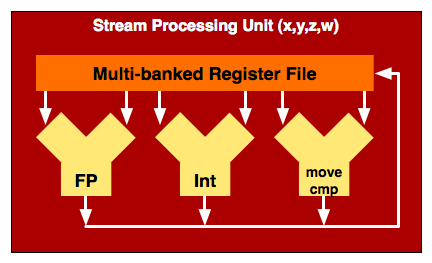
AMD's Stream Processing Unit is very similar to NVIDIA's SP in G80/G92/GT200, so similar in fact that I drew them the same way. Keep in mind that the actual inner workings of one of these units is far more complex than three ALUs but to keep things simple and consistent that's how I drew it (the actual hardware is a fused FP MUL + ADD unit, for those who care). AMD has four of these stream processing units in a processor block and they are called x, y, z or w units.
There's a fifth unit called a t-unit (the t stands for transcendental, meaning the type of operations it is capable of processing):

The t-unit can do everything a x,y,z or w-unit can do, but it also can do transcendental operations (represented by the SFU block in the diagram above). NVIDIA has the same functionality, it simply chooses to expose it in a different way (which we'll get to shortly). AMD considers each one of these units (x,y,z,w and t) a processing unit, and the RV770 has 800 of them (the RV670 had 320).
AMD pairs four of these stream processing units (x,y,z and w) with a t-unit and puts them together as a block, which I have decided to call a Streaming Processor (SP):

The area in red is actually the SP, but unlike one of NVIDIA's SPs, one of AMD's can handle up to five instructions at the same time. The only restriction here is that all five units have to be working on the same thread.
AMD then groups 16 of these SPs into something they like to call a SIMD core (AMD has less confusing, but far worse names for its architectural elements than NVIDIA):
|
AMD's SIMD Core
|
NVIDIA's SM
|
 |
 |
A SIMD core is very similar to NVIDIA's SM with a couple of exceptions:
1) There are more SPs in AMD's SIMD Core (16 vs 8)
2) The SPs are wider and can process, at peak, 5x the number of instructions as NVIDIA's SPs
3) The Instruction and Constant caches are not included in the SIMD core, AMD places them further up the ladder.
4) AMD pairs its texture units and texture cache with its SPs at the SIMD core level, while NVIDIA does it further up the ladder.
5) See the two SFUs in NVIDIA's SM? While NVIDIA has two very fast Special Function Units in its SM, AMD equips each SP with its own SFU. It's unclear which approach is actually faster given that we don't know the instruction latency or throughput of either SFU.
Note that at this point, the RV770 is really no different than the RV670 (the GPU used in the Radeon HD 3870). The next step is where AMD and NVIDIA really diverge; while NVIDIA's GT200 takes three SMs and groups them into a Texture/Processing Cluster (TPC) and then arranging 10 TPCs on its chip, AMD simply combines 10 SIMD cores:
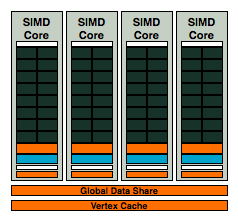
AMD's RV670
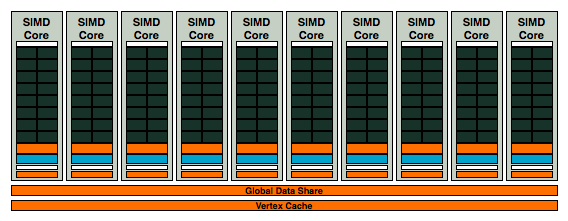
10 SIMD cores at your disposal in AMD's RV770, this is how AMD goes from competitive, to downright threatening
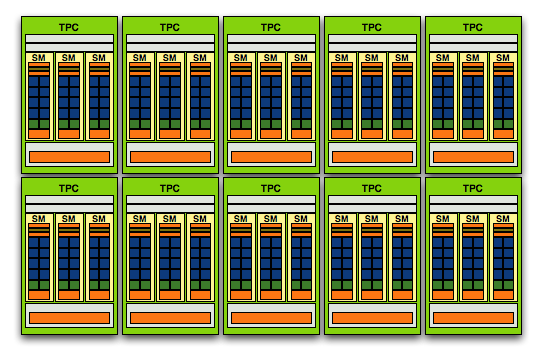
NVIDIA's GT200 Streaming Processor Array (SPA), it has fewer execution resources but more encapsulation around them, the focus here is on thread management
With 10 SIMD cores the RV770, it has 2.5x the number of execution units as a RV670. It even has more theoretical processing power than NVIDIA's GT200. If you just look at the number of concurrent instructions that can be processed on RV770 vs. GT200, the RV770's 800 execution units to GT200's 240 (+ 60 SFUs) is in a completely different league.
| NVIDIA GT200 | AMD RV770 | AMD RV670 | |
| SP Issue Width | 1-way | 5-way | 5-way |
| # of SPs | 240 | 160 | 64 |
| Worst Case Dependent Instruction Throughput | 240 | 160 | 64 |
| Maximum Scalar Instruction Throughput | 480* | 800 | 320 |
We'll be talking about efficiency and resource utilization in the coming pages, but immediately you'll notice that the RV770 (like the RV670 and R600 that came before it) has the potential to be slower than NVIDIA's architectures or significantly faster, depending entirely on how instruction or thread heavy the workload is. NVIDIA's architecture prefers tons of simple threads (one thread per SP) while AMD's architecture wants instruction heavy threads (since it can work on five instructions from a single thread at once).
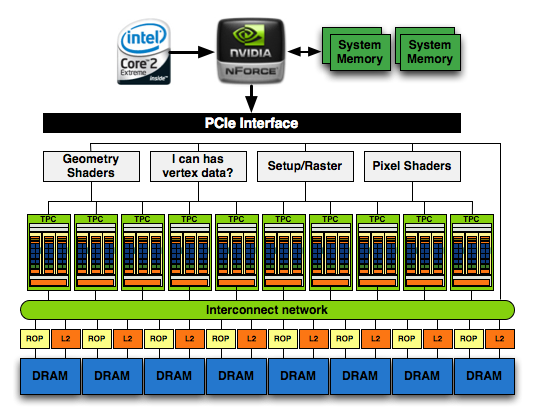
NVIDIA's GeForce GTX 280
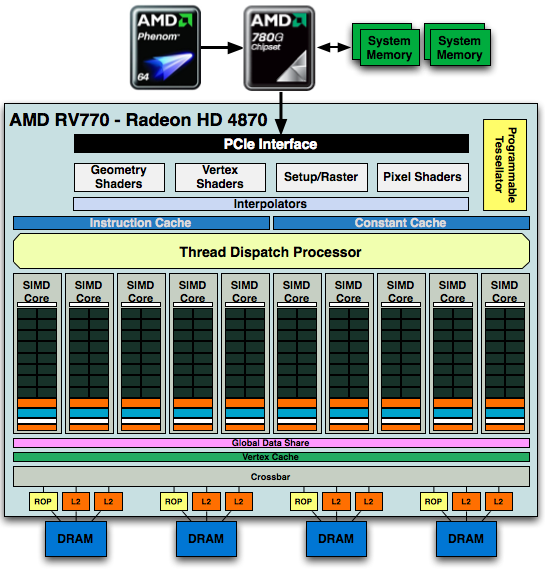
AMD's Radeon HD 4870
The full GPU is pretty impressive:
1) See the Instruction and Constant Caches up top? NVIDIA includes them in each SM while AMD seems to include them outside of the SIMD core clusters.
2) The RV770 only has four 64-bit memory controllers compared to the eight in GT200
3) The Programmable Tessellator is left over from the Xbox 360's GPU (and R600/RV670), unfortunately it is unused by most developers as there is no DirectX support for it yet.
4) AMD has dedicated hardware attribute interpolators, something NVIDIA's hardware shares with its special function units (SFUs).
Other than the differences we mentioned above, AMD's architecture is similar in vain to NVIDIA's, there are just a handful of design choices that set the two apart. Just like NVIDIA took its G80/G92 architecture and made it larger, AMD did the same with RV770 - it took RV670 and more than doubled its execution resources.
AMD took a bigger leap with RV770 from RV670 than NVIDIA did from G80/G92 to GT200, but it makes sense given that AMD had to be more competitive than it even was in the last generation.










215 Comments
View All Comments
StevoLincolnite - Wednesday, June 25, 2008 - link
Of course it can, There are benchmarks isn't there?Seriously ANY Direct X 9 card can run Crysis, The Quality and Performance is a different matter.
Inkjammer - Wednesday, June 25, 2008 - link
I have a 9800 GX2 in my primary gaming rig, but I've been debating on what card to drop into my Photoshop/3DS Max art rig. I've been waffling over it for some time, and was going to settle on an 8800GT... but after seeing this, my mind's set on the 4850. It definitely appears to offer more than enough power to handle my art apps, and allow me to use my second PC a gaming rig if need be... all without breaking the bank.This'll mark my return to buying ATI hardware since the X800 was king.
weaksideblitz - Wednesday, June 25, 2008 - link
this is a welcome development although im only buying a 4850 :)Locutus465 - Wednesday, June 25, 2008 - link
Very much so, actually from where I sit I think all AMD really needs to do is get a SAM2+ CPU out there that can compete with intel at least similarly to how this card competes with nvida and they'd have one hell of a total platform solution right now. As for upgrading my vid card... I just finished upgrading to the Phenom 4x and Radeon 3870 so I'll be sticking with that for a while. Quite honestly that platform can pretty much run anything out there already as it is, so I'm feeling pretty confident my current setup will last a couple years at least.Lifted - Wednesday, June 25, 2008 - link
Ditto. If I can get a 4850 for ~$150 or so, that's what I'm doing as well.billywigga - Friday, August 29, 2008 - link
where are you getting it from best buy or somethingClauzii - Wednesday, June 25, 2008 - link
That leaves 50 for a better cooler ;)Lifted - Wednesday, June 25, 2008 - link
Is there any reason the first pages of benchmarks have SLI setups included in the charts, but you wait until the end of the article to add the CF? I'd think it would make the most sense to either include both from the start or hold both until the end.Anand Lal Shimpi - Wednesday, June 25, 2008 - link
The original idea was to format it like the 4850 preview, keep things simple early on but offer SLI/CF graphs later in the article for those who wanted them.It looks like in the mad rush to get things done it didn't work out that way, I'll see if it's possible to clean it all up but right now we've got a lot of other minor touchups to do first :)
Take care,
Anand
TechLuster - Wednesday, June 25, 2008 - link
Anand,I really like your idea of "keeping things simple early on" by only including configurations that us mere mortals can afford at first (say, all single-GPU configs plus "reasonable" multi-GPU configs less than ~$400 total), and then including numbers for ultra high-end multi-GPU configs at the end (mainly just for completeness and also for us to drool over--I doubt too many people can afford more than one $650 card!).
Anyway, great job on the review as always. I think you and Derek should get some well-deserved rest now!
-TL